| Previous page | Table of Contents | Next page |
Luncheons Review - February, April, May
Master of Momentum
Presented by Cary Mullen
February 28, 2002
At the time of the year when skiing can be the 'sport of choice' for most Calgarians, Cary Mullen shared his skiing exploits, learnings and journey of growth with the PJVA luncheon crowd. Cary was part of the "Crazy Canucks" ski team in the 1980's and he has taken the experiential lessons from sport and translated it into techniques which help others achieve their own personal and professional aspirations.
Cary introduced his talk by having the audience progress from his youth skiing competitions at Sunshine Village to making the Canadian Ski Team and then traveling to the USA and Europe for numerous races. By giving us a descriptive narrative of his drive for skiing excellence, the audience felt like they were 'along for the ride' as he set the downhill speed record on the treacherous mountain, The Hahnenkam in Kitzbuhel, Austria. We all held our breath until he took us across that finish line.
Cary was charismatic, funny and enlightening as he combined the story of his youth, his passion for a goal and attainment of his goal. His energy was clearly demonstrated as he wove his skiing tales into steps that we could use to approach challenges from a different perspective. Cary recommended that we take a proactive approach to accepting challenges and change. The "Mullen Triangle for Success" was presented as a model to apply to our daily life. The importance of Passion, Knowledge and Action was emphasized as the corners of this triangle leading towards accomplishment of our goals. The luncheon audience left with renewed enthusiasm for their tasks and a good look into the life and challenges of a downhill ski racer. Not a profession for the faint of heart.
Cary Mullen offers companies and individuals a unique variety of services to help organizations maximize their opportunities and tap their full potential. From motivational speaking to ski retreats and team building, his development programs can be customized to meet many needs. Cary may be contacted at (403) 248-0444 or via email at carymullen@shaw.ca.
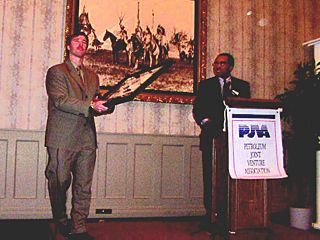
February luncheon speaker, Cary Mullen |
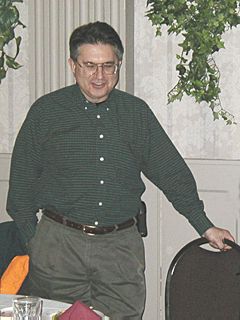
Bill Morgan |
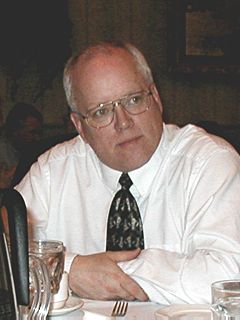
Paul O'Gorman |
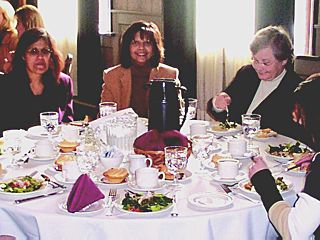
Shashee Pallan, Nan Deen, and Barbara Walters |
Canadian Natural Resources: Ladyfern Project
Presented by David Cousins
April 18, 2002
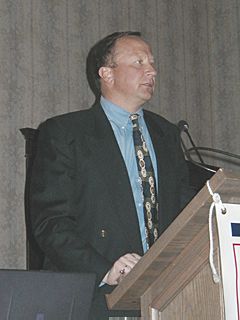
Location
Located in blocks G, H, I/94-H-1 in NE BC and 94-13W6 in NW Alberta (2 1/2 hour drive north of Fort St. John). The area is mainly muskeg, which means winter access. Locations are inside Doig First Nations traditional territory.
History
Discovery well a-97-H/94-H-1 was drilled January 2000 and produced 41 mmscfd April to December 2000. Murphy/Apache, AEC and CNRL drilled step out follow up wells through 2001 and 2002.
Geology
Middle Devonian, Lower Slave Point member of Beaverhill Lake Group. Originally a reef structure that has been subjected to hydrothermal dolomitization affecting both reef rim and interior. Well locations were picked from 3D seismic. Reservoir - reef rim. Porosity - 15 to +25%, thickness - up to 20 m of pay, k - 100s of millidarcies - vuggy, Sw - 8 to 23% and PR - 31 Mpa. Depth - +/- 2825 m. Pool. Reserves estimates - 0.7 to 1 TCF.
Gas Composition
Methane - 93.5%
Ethane - 1.17%
Propane + - 0.30%
CO2 - 4.0%
H2S - 25 to 30 ppm
Typical drill/complete
Drill to top of Slave Point with conventional drilling rig (+/-2775 m). Drill out Slave Point under balanced with service rig or coiled tubing. Run 4 1/2" Chrome 13 tubing due to CO2 corrosion concerns. $3,000,000 drill and complete.
Well Deliverability and Test Rates
Test duration limited due to flaring permits issued by OGC - 1100 e3m3 during drilling and completion.
82G - 18.5 mmscfd @ 3365 psig (3% draw down)
74G - 18.5 mmscfd @ 3323 psig (2% draw down)
86G - 22 mmscfd @ 3193 psig (4% draw down)
Many wells have AOFs of over 100 mmscfd using
n = 0.7 (as per PSA).
Development
CNRL drilled seven wells in 2001 and five more in 2002:
1st well, 57-G on production March/01 at 2 mmscfd,
2nd well, 82-G on production June/01 to Westcoast at 55 - 60 mmscfd/d, and
3rd well, 74-G on production September/01 to Westcoast at 50 mmscfd/d.
Total production over 100 mmscfd. Turned on three more wells December 1/01. Put on sixth big well January 1/02. Production up to 205 mmscfd.
Installed 20" NEB pipeline to TCPL and placed into service March/02. Commissioned 220 mmscfd dehy plant and placed in service March/02. CNRL production up to 215 mmscfd.
Typical wellsite
Wellhead choke, 6" wellhead piping, 6" meter run - 900 ansi, 12" x 99' flare stack, 1775 hp compressor, and scada equipment
Operating
Installed 5 1/2" tubing in four wells. Wellhead flowing pressure +/- 2000 psi. TCPL delivery pressure +/- 1200 psi. H2S reduced to TCPL spec with scavenger in gas gathering system.
Joint Venture Issues
Ladyfern is a classic drainage race with a huge prize - BCFs of gas. The locations are limited access and time-sensitive. He who has the most big wells and pipe wins. Initial discussions developed in attempt to avoid overcapitalizing the pool.
PSA Agreement
Production sharing agreement worked out between Murphy, Apache, AEC and CNRL Pool production cap based on set pipeline takeaway capacity. It was decided to limit well production based on well deliverability. A big well was defined as any well with a rate of over 70 mmscfd with 50% draw down on SI wellhead pressure. Any well with less than 70 mmscfd would be that % of a big well. Company production allowable was based on number of big wells and well allowables.
Exciting in a way that is rarely seen anymore. It must have seemed like the much-storied good ol' days to oil patch veterans. This play was new, open and big. Good geology and geophysics were directing where to drill. A real land rush and gambling with bundles of cash to determine if the gas was really there. Then develop as fast as we can. Don't be left behind! We want to have the biggest stack of chips come the day that we hunker down and negotiate.
Ladyfern is a project with everything in the mix; regulation limited well tests, native lands, financing driven joint venture negotiations, remote location, non-existent infrastructure, winter only access and, most importantly, about a trillion cubic feet of gas available with high flow rates.
Of all the challenges faced in this project by the various participants, the interesting one was the production sharing agreement reached by area producers. They came together and, resisting the obvious temptations, reached an agreement to share production and the cost of development. Each party will undoubtedly be further ahead.
Chalk one up for reasoned discourse and remember Ladyfern's lesson to us all. "Give a little bit and gain a lot".
Paul O'Gorman
In My Opinion: Canadian Natural Resources Ltd: Ladyfern Development
Aid Distribution to the Afghan Refugees
Presented by Ash Khan
May 18, 2002
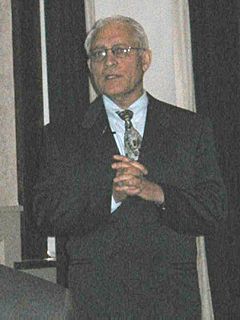
Following the September 11, 2001 tragedy, many Canadians felt compelled to help the American victims and their families by donating time, money and blood to the Red Cross. Additionally, many Canadians were introduced to the plight of the Afghan people as the war on terrorism progressed in their home country.
I was deeply concerned with this unfolding human tragedy where hundreds of thousands of Afghan refugees, victims of American and Northern Alliance bombings, were forced to seek shelter in neighboring countries. As a retired Petroleum Engineer in Calgary and with an interest in international development, I became involved with a group know as Face to Face.
The idea of Face to Face began to gel in late September 2001 in the small city of Chilliwack, B.C. The community wanted to directly help these Afghan refugees by personally delivering humanitarian aid to the camps in Peshawar, Pakistan.
A friend in Chilliwack put me in touch with Face to Face, which was headed by the publisher and editor of a local paper. I was moved by their courage to travel to Pakistan to deliver the aid and offered my services immediately. As an immigrant from that area, I felt I would be an asset to the team in translating as well as ensuring their safety. Face to Face was delighted to have a third Canadian on board for this mission.
The local Chilliwack newspaper began publicizing the humanitarian aid project and soon the entire city of 60,000 people took up the cause. Students at the Greendale elementary school and other lower mainland schools started their fund raising efforts through "Kids Helping Kids" campaigns by donating their weekly allowances for the Afghan kids. The local businesses, colleges and community and church organizations involved themselves in this worthy cause through generous donations of money and services. The expectation was to raise $10,000; however, by the end of December, the response was overwhelming, with more than $65,000 raised.
We arrived in Islamabad, Pakistan on New Year's Eve and left for Peshawar the following day. The Rotary Club of Peshawar was instrumental in arranging camp visitation and aid distribution. We visited four camps and a hospital in the Peshawar area as well as a field hospital in Torkhum at the Pakistan -Afghanistan border. These camps, which have been set up across the North West Frontier Province of Pakistan, house anywhere from 1,000 to over 75,000 families.
We first distributed food aid to the largest, most dilapidated camp known as Jaluzai, where we selected the poorest 1,500 families identifed by our local NGO contact. A ration card was issued to each of the 1,500 families to pick up the aid at our distribution centre from a discrete location away from the refugee camp. This was necessary to avoid a mad rush by other refugees desperately hoping to collect food aid. It was the most heartwrenching experience, as the need for help was so great and we could help only a fraction of the refugee population.
Our next several days were spent visiting schools and hospitals that tended to the refugees. The primary schools we visited were located in Katchagiri and Khazana camps and were run by the United Nations High Commission for Refugees (UNHCR). Boys and girls up to grade six were taught separately in morning and afternoon shifts. The children had to sit on dirty tarpaulins on cold cement floors. This prompted our first decision to supply synthetic 10 x 14 foot mats to five elementary schools in the area.
At the nearby Naseer camp, we provided the teaching hospital with US $4,000 worth of medicines bought locally. This hospital sees over 400 patients daily, many of which are Afghan refugees, and performs over 900 surgeries a month.
The following day we visited a field hospital at Torkhum, on the Afghan border, and donated over US $1,000 in medicines. After visiting three other camps, we adopted one small camp of 1,200 families to concentrate our aid distribution. The Rotary Club and the local camp commander assisted with the logistics of distributing flour, sugar, cooking oil and warm clothing to the families. As the children had no toys, we supplied soccer balls, cricket bats and other sporting equipment.
We believe that by personally delivering this humanitarian aid, we were able to target the most needy refugees while incurring little overhead as we paid for our own flights or were sponsored. Upon our return to Canada, additional monies donated to Face to Face, amounting to Cd $30,000 through the doubling of donations by the Rotary International were sent to the Peshawar Rotary Club.
Ash Khan is a retired Petroleum Engineer, a member of PJVA, and active in international development.
Photo by WFP/Mike Huggins, WFP/Clive Shirley, or Hafeez Yakoobi We are all familiar with chequebook charity. It's something Calgarians do in record numbers, even though we volunteer wherever we can. We contribute to the cause when we believe but can't be active.
The good people of Chilliwack, British Columbia have gone the extra mile. They combined direct action and contributions into a powerful force for good called Face to Face (F2F) and went directly to the front lines of international refugee assistance.
An action team consisting of PJVA alumnus Ash Khan and two F2F representatives traveled to Pakistan with tremendous community support in the form of $60,000. Once there, they used the Pakistan government, many non-Governments organizations and members of the local Rotary club to acquire and distribute large quantities of food, medicines, educational supplies and sports equipment. All the gifts were presented directly to the families in need. There were no losses to corruption, overhead or extravagance. In many instances the local authorities worked to ease the path.
Simple, direct and effective. F2F has recognized that the children of Afghanistan are dying in heart breaking numbers. They are sick, malnourished, orphaned, tragically undereducated, and in desperate need. Further, F2F realizes that the current conflict only escalates the conditions created by the Russian invasion and the subsequent decades of strife. So, they acted. And continue to do so by providing aid to one of the camps suffering under the gravest of conditions, filled with people who walked three weeks to avoid the Afghanistan conflict, escaping only with what they could carry. The support and comfort brought by F2F to Afghanistan may not have been more than a drop in the bucket, but it makes the bucket fuller.
To find out more regarding this novel charity please visit
www.face-to-face.ca.
Paul O'Gorman
In my Opinion: Afghanistan Face to Face
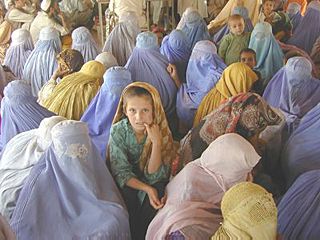
| Previous page | Table of Contents | Next page |